Pi Network has emerged as a distinctive player in the cryptocurrency landscape, offering a novel approach to digital asset mining that prioritizes accessibility and environmental sustainability. Launched in 2019, the platform has attracted millions of users by enabling Pi coin mining directly from smartphones, a stark contrast to the energy-intensive mining processes of traditional cryptocurrencies like Bitcoin. This unique model has sparked both enthusiasm and skepticism, prompting a closer examination of Pi Network’s current market dynamics, price fluctuations, and future prospects.
As of July 9, 2025, the price of Pi coin stands at approximately $0.46 USD, with minor variations observed across different exchanges and reporting platforms. The price range typically fluctuates between $0.45 and $0.47 USD, reflecting discrepancies in data aggregation methods and trading volumes on various platforms. Pi Network’s market capitalization is estimated at around $3.5 billion USD, a substantial figure that underscores its theoretical market presence. However, it is essential to note that this valuation is based on the total supply of Pi coins mined, with the actual circulating supply and transaction capabilities still limited due to the network’s enclosed mainnet phase.
The 24-hour trading volume for Pi coin exhibits significant variability, ranging from $4 million to $60 million USD, depending on the reporting source. This inconsistency highlights the challenges in accurately assessing Pi’s market activity, as trading primarily occurs on IOU (I Owe You) markets or within limited exchange environments. The speculative nature of Pi’s valuation is driven by several factors, including the anticipation of future utility and adoption, the size and engagement of the network’s user base, and the progress of Pi Network’s development. Positive developments, such as the launch of new features and strategic partnerships, can significantly boost investor sentiment and drive up the price. Conversely, a bearish market environment can exert downward pressure on Pi’s valuation.
Pi Network’s current operational model, the enclosed mainnet, presents both advantages and disadvantages. This controlled environment allows the core team to maintain a secure and compliant ecosystem, facilitating the development of Pi-based applications and utilities. However, the restricted trading environment limits the liquidity of Pi coins, hindering price discovery and potentially suppressing its value. The centralized nature of the enclosed mainnet also raises concerns about control and transparency, with critics arguing that the Pi Network core team holds too much power over the network. Additionally, price discrepancies between different IOU markets and internal Pi marketplaces make it difficult to establish a fair and accurate market value.
The unique mining mechanism of Pi Network, which allows users to earn Pi coins by simply checking into the app daily, has democratized cryptocurrency participation, making it accessible to individuals who lack the resources for traditional mining. This inclusivity has contributed to the platform’s rapid user growth. However, the ease of mining Pi has led to questions about the intrinsic value of the coin. Critics argue that the abundance of Pi coins could dilute their value over time. To address this, the Pi Network core team has implemented measures such as halving the mining rate as the network grows and introducing mechanisms to burn Pi coins.
The future of Pi Network hinges on its ability to successfully transition to an open mainnet and build a thriving ecosystem of applications and utilities. The transition to an open mainnet is crucial for enabling free trading and exchange of Pi coins, facilitating price discovery, and increasing liquidity. The timing and execution of this transition will be critical to Pi Network’s long-term success. Additionally, the development of useful and engaging applications within the Pi ecosystem is essential to driving demand for Pi coins. This includes e-commerce platforms, social networks, and other utilities that leverage Pi as a medium of exchange.
Navigating the complex and evolving regulatory landscape for cryptocurrencies presents a significant challenge for Pi Network. The platform must ensure compliance with applicable laws and regulations in various jurisdictions to avoid legal and financial risks. Furthermore, Pi Network faces competition from other cryptocurrencies and blockchain platforms. To succeed, it must differentiate itself through its unique value proposition and execution. As the network grows, scalability will be essential for maintaining a smooth and efficient user experience, ensuring that the infrastructure can handle increasing transaction volumes.
In conclusion, Pi Network offers a compelling vision of a decentralized and accessible cryptocurrency, with the potential to disrupt the traditional cryptocurrency landscape. Its innovative mining mechanism and large user base provide a strong foundation for growth. However, the project faces significant challenges, including the need to transition to an open mainnet, develop a thriving ecosystem, and navigate regulatory hurdles. The success of Pi Network will ultimately depend on its ability to deliver on its promises and overcome these challenges. Whether it becomes a revolutionary force in the world of digital finance or fades into obscurity remains to be seen, but its journey is undoubtedly one worth watching.





